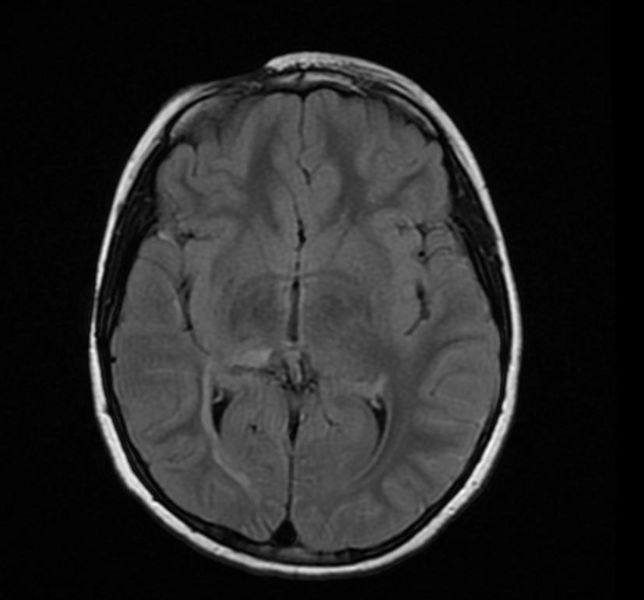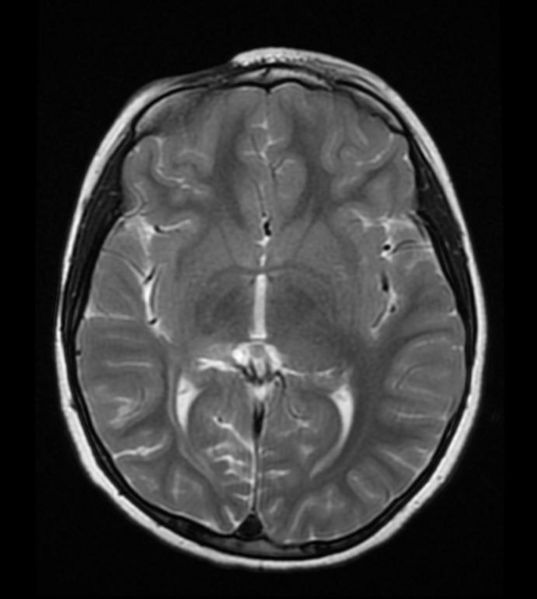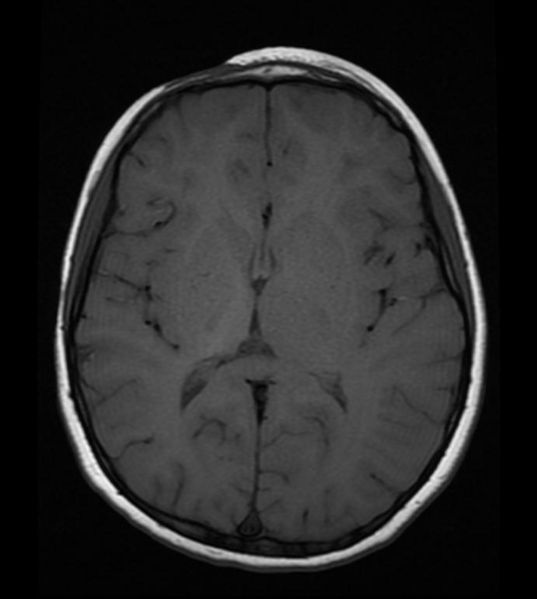Parry-Romberg syndrome
| Parry-Romberg syndrome | |
| ICD-10 | G51.8 |
|---|---|
| ICD-9 | 349.89 |
| OMIM | 141300 |
| DiseasesDB | 30151 |
| MeSH | D005150 |
Editor-In-Chief: C. Michael Gibson, M.S., M.D. [1]
Overview
Parry-Romberg syndrome (sometimes called just Romberg syndrome) is a rare, incurable craniofacial disorder which is characterized by the slow atrophy of the subcutaneous (under the skin) muscle usually on half of the face (hemifacial atrophy). It has a higher prevalence in females and normally appears between the ages of 5 and 15. The condition also causes neurological symptoms, including seizures and severe facial pain.[1]
It is classified as a rare disease in the United States.
Historical Perspective
The name comes from Parry (1825) and Henoch and Romberg (1846) who first described the disease.[2][3]
Classification
- [Disease name] may be classified according to [classification method] into [number] subtypes/groups:
- [group1]
- [group2]
- [group3]
- Other variants of [disease name] include [disease subtype 1], [disease subtype 2], and [disease subtype 3].
Pathophysiology
- The pathogenesis of [disease name] is characterized by [feature1], [feature2], and [feature3].
- The [gene name] gene/Mutation in [gene name] has been associated with the development of [disease name], involving the [molecular pathway] pathway.
- On gross pathology, [feature1], [feature2], and [feature3] are characteristic findings of [disease name].
- On microscopic histopathological analysis, [feature1], [feature2], and [feature3] are characteristic findings of [disease name].
Causes
- [Disease name] may be caused by either [cause1], [cause2], or [cause3].
- [Disease name] is caused by a mutation in the [gene1], [gene2], or [gene3] gene[s].
- There are no established causes for [disease name].
Differentiating [disease name] from other Diseases
- [Disease name] must be differentiated from other diseases that cause [clinical feature 1], [clinical feature 2], and [clinical feature 3], such as:
- [Differential dx1]
- [Differential dx2]
- [Differential dx3]
Epidemiology and Demographics
- The prevalence of [disease name] is approximately [number or range] per 100,000 individuals worldwide.
- In [year], the incidence of [disease name] was estimated to be [number or range] cases per 100,000 individuals in [location].
Age
- Patients of all age groups may develop [disease name].
- [Disease name] is more commonly observed among patients aged [age range] years old.
- [Disease name] is more commonly observed among [elderly patients/young patients/children].
Gender
- [Disease name] affects men and women equally.
- [Gender 1] are more commonly affected with [disease name] than [gender 2].
- The [gender 1] to [Gender 2] ratio is approximately [number > 1] to 1.
Race
- There is no racial predilection for [disease name].
- [Disease name] usually affects individuals of the [race 1] race.
- [Race 2] individuals are less likely to develop [disease name].
Risk Factors
- Common risk factors in the development of [disease name] are [risk factor 1], [risk factor 2], [risk factor 3], and [risk factor 4].
Natural History, Complications and Prognosis
Natural History
Parry-Romberg syndrome is a rare disorder characterized by slowly progressive degeneration (atrophy) of the soft tissues of half of the face (hemifacial atrophy). Some individuals may experience distinctive changes of the eyes and hair; and neurological abnormalities including episodes of uncontrolled electrical disturbances in the brain (seizures) and episodes of severe pain in tissues supplied by the fifth cranial nerve (trigeminal nerve) including the mouth, cheek, nose, and/or other facial tissues (trigeminal neuralgia). Symptoms and physical findings associated with Parry-Romberg syndrome usually become apparent during the first or early during the second decade of life. In rare cases, the disorder is apparent at birth. The majority of individuals with Parry-Romberg syndrome experience symptoms before the age of 20 years.
In individuals with the disorder, initial facial changes usually involve the tissues above the upper jaw (maxilla) or between the nose and the upper corner of the lip (nasolabial fold) and progress to involve the angle of the mouth, the areas around the eye, the brow, the ear, and/or the neck. Progressive tissue wasting can be on either side of the face. In some rare cases, the atrophy may be bilateral. Affected areas may demonstrate shrinkage and atrophy of tissues beneath the skin (subcutaneous tissue), the layer of fat under the skin (subcutaneous fat), and underlying cartilage, muscle, and bone.
In addition, the skin overlying affected areas may become darkly pigmented (hyperpigmentation) with, in some cases, areas of hyperpigmentation and patches of unpigmented skin (vitiligo). Many individuals also experience atrophy of half of the upper lip and tongue as well as abnormal exposure, delayed eruption, or wasting of the roots of certain teeth on the affected side. Symptoms of Parry-Romberg syndrome may begin at any age. Facial atrophy may cease abruptly, or progress slowly and then become stationary. If the atrophy becomes stationary, it may reactivate later in life. In other cases, the atrophy may progress indefinitely. In some cases, hair abnormalities may also appear on the affected side, including whitening (blanching) of the hair as well as abnormal bald patches on the scalp and loss of eyelashes and the middle (median) portion of the eyebrows (alopecia).
In addition, some individuals with Parry-Romberg syndrome may also experience associated neurological abnormalities. These may include severe headaches that last for extended periods of time and may be accompanied by visual abnormalities, nausea, and vomiting (migraines); facial pain (trigeminal neuralgia); and/or periods of uncontrolled electrical disturbances in the brain (seizures) that usually are characterized by rapid spasms of a muscle group that spread to adjacent muscles (contralateral Jacksonian epilepsy). The range and severity of associated symptoms and findings may vary from case to case. In most cases, Parry-Romberg syndrome appears to occur randomly for unknown reasons (sporadically).[4]
Complications
Prognosis
The prognosis for individuals with Parry-Romberg syndrome varies. In some cases, the atrophy ends before the entire face is affected. In mild cases, the disorder usually causes no disability other than cosmetic effects.
Diagnosis
Marked thinning of the skin in the right frontal region is consistent with Parry Romberg syndrome
Diagnostic Criteria
- The diagnosis of [disease name] is made when at least [number] of the following [number] diagnostic criteria are met:
- [criterion 1]
- [criterion 2]
- [criterion 3]
- [criterion 4]
Symptoms
- [Disease name] is usually asymptomatic.
- Symptoms of [disease name] may include the following:
- [symptom 1]
- [symptom 2]
- [symptom 3]
- [symptom 4]
- [symptom 5]
- [symptom 6]
Physical Examination
- Patients with [disease name] usually appear [general appearance].
- Physical examination may be remarkable for:
- [finding 1]
- [finding 2]
- [finding 3]
- [finding 4]
- [finding 5]
- [finding 6]
Laboratory Findings
- There are no specific laboratory findings associated with [disease name].
- A [positive/negative] [test name] is diagnostic of [disease name].
- An [elevated/reduced] concentration of [serum/blood/urinary/CSF/other] [lab test] is diagnostic of [disease name].
- Other laboratory findings consistent with the diagnosis of [disease name] include [abnormal test 1], [abnormal test 2], and [abnormal test 3].
Imaging Findings
- There are no [imaging study] findings associated with [disease name].
- [Imaging study 1] is the imaging modality of choice for [disease name].
- On [imaging study 1], [disease name] is characterized by [finding 1], [finding 2], and [finding 3].
- [Imaging study 2] may demonstrate [finding 1], [finding 2], and [finding 3].
Other Diagnostic Studies
- [Disease name] may also be diagnosed using [diagnostic study name].
- Findings on [diagnostic study name] include [finding 1], [finding 2], and [finding 3].
Treatment
=Medical Therapy
There is no cure and there are no treatments that can stop the progression of Parry-Romberg syndrome. Reconstructive or microvascular surgery may be needed to repair wasted tissue. The timing of surgical intervention is generally agreed to be the best following exhaustion of the disease course and completion of facial growth. Most surgeons will recommend a waiting period of one or two years before proceeding with reconstruction. Muscle or bone grafts may also be helpful. Other treatment is symptomatic and supportive.
Surgery
Prevention
External links
References
- ↑ Template:NINDS
- ↑ Template:WhoNamedIt
- ↑ Cory RC, Clayman DA, Faillace WJ, McKee SW, Gama CH (1997). "Clinical and radiologic findings in progressive facial hemiatrophy (Parry-Romberg syndrome)". AJNR Am J Neuroradiol. 18 (4): 751–7. PMID 9127045.
- ↑ Parry Romberg Syndrome


